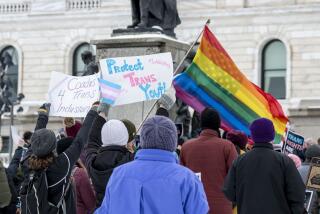The Case Against the Notion of ‘Homosexual Panic’
- Share via
Everyone knows what it feels like to be approached by Mr. or Miss Wrong, the one person in the room to whom you are most definitely not attracted. Such a come-on could make someone cringe or even slightly sick, sure, but could it actually drive a person to murder?
The notion that an unwanted sexual advance, particularly by a gay person toward a straight one, might spark “sex panic” and result in an uncontrollable, murderous rage has been raised in courtrooms as a defense tactic in the last few years.
Most recently, the issue swirled at the edges of the trial of the second man convicted of murdering Wyoming college freshman Matthew Shepard. Defendant Aaron McKinney’s attorneys wanted to argue their client lost control after Shepard, who was gay, propositioned McKinney in October 1998. But state District Judge Barton Voigt prohibited the use of the controversial strategy, reasoning that it was not allowed under state law.
Still, the question lingers: Is there such a thing as “homosexual panic”?
In a word, no, according to those who study human behavior. The notion of “homosexual panic” seems to be based on the Freudian theory that buried motivations and fears can be triggered by events or thoughts, and lead to aberrant behavior. The phrase is believed to have been coined in 1920.
(Indeed, McKinney’s lawyers argued that an advance by Shepard triggered memories of a childhood homosexual assault, setting off “five minutes of emotional rage and chaos,” during which McKinney pistol-whipped Shepard into a coma from which he never recovered.)
As a legal defense, the theory was explored in a 1989 Harvard Law Review article. “Homosexual panic” defense, said the piece, is based “on the theory that a person with latent homosexual tendencies will have an extreme and uncontrollably violent reaction when confronted with a homosexual proposition.”
But a year earlier, in 1988, two Canadian psychiatrists reviewed literature on the subject dating back to 1920 and concluded in the Canadian Journal of Psychiatry that the term “should be permanently assigned to the junkyard of obsolete psychiatric terminology.”
“Homosexual panic” is not a mental disorder, they said; rather it is a culmination of our culture’s homophobic attitudes.
Although psychologists and psychiatrists discount the theory, some researchers are probing the links between homophobic attitudes and antigay violence.
A psychology professor in Georgia says his research demonstrates that denied homosexual urges may indeed drive some people to violence. Henry E. Adams of the University of Georgia in Athens tested the theory by administering an “Index of Homophobia” test to 64 men between the ages of 18 and 31. The men were then shown explicit erotic videos of heterosexual, homosexual and lesbian sex while hooked up to a device that measures arousal by tracking changes in penile circumference.
Those identified as homophobic were more aroused by the homosexual videos than by the heterosexual videos. Those identified as nonhomophobic were more aroused by the heterosexual videos. (It will come as no surprise to anyone who watched last week’s “Ally McBeal” that lesbian sex was a hit with both groups.)
“The body doesn’t lie,” said Adams. “The homophobes despise the fact that they get aroused by men and they deny it.” In a yet-to-be-published study, Adams will report that homophobes grew anxious, hostile and aggressive after watching gay erotica. (The nonhomophobes did not.)
After the initial tests, he introduced another designed to determine whether those identified as homophobic would actually inflict pain on gays if given the chance.
His subjects competed with opponents identified as gay or straight. The winner got to deliver a minor shock to the loser.
“Sure enough,” said Adams, “homophobics shocked the hell out of the person they were told was gay and they didn’t to the guy they were told was heterosexual. I am not sure what it means, but when homophobics get aroused, they do get angry, hostile and violent.”
Adams thinks that this link between sexual arousal and aggression is what distinguishes those he calls “homo-negative” (people who for religious, social or moral reasons disapprove of gays) from “homophobic” (someone who may want to do harm).
And, he said, panic is probably not an operative part of that aggressiveness. “Panic is something that happens immediately, almost like fight or flight,” said Adams. “Antigay crimes are more planned than a heat-of-passion crime. There is a plan and instigation to get these victims out somewhere to beat them up and kill them.”
Gay activists and others say the term “homosexual panic” has survived so long because it reflects an antigay culture. “It is culturally acceptable to respond violently to a homosexual proposition. . . . The idea is you have the right to defend your masculinity,” says Karen Franklin, an El Cerrito forensic psychologist who studies antigay behaviors and attitudes. “Of course what is a proposition and what is a flirtation is in the eye of the beholder. If a man allows another man to flirt with him, he is viewed as no longer masculine in our culture, where there is a tremendous fear of losing masculinity.”


